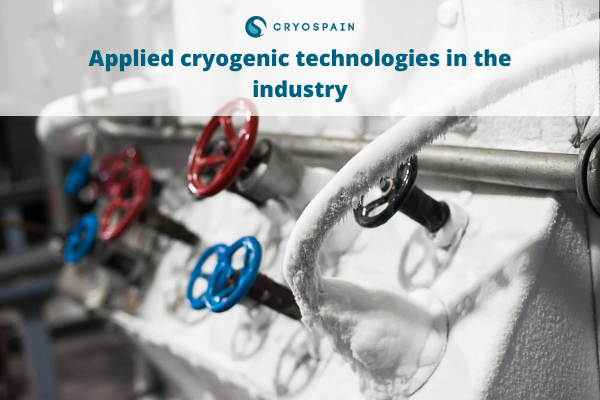Applied cryogenic technologies haven’t stopped growing since multiple industries have discovered the potential of cryogenic technologies.
The concept of cryogenics revolves around subjecting different materials and elements to very low temperatures (typically temperatures below -180 °C or 93.2 K). This has resulted in implications for a wide range of industries and subjects, as the benefits of cryogenic substances are increasingly known and expanded.
What are the current fields where cryogenic technologies are used in and how is cryogenic tech enlarging different industries’ possibilities and efficiencies? Keep reading to find out
The versatility of applied cryogenic technologies
The key to understanding why applied cryogenic technologies are favored today lies in these two reasons:
- They enhance storage. When certain substances are subjected to cryogenic temperatures and thus liquefied, they exist at higher densities and lower pressures, so that their storage is simpler and requires less space for a higher amount of material. This is the case of the cryogenic tanks for gas storage.
- Certain chemical and manufacturing processes (which we specify below) can only take place when cryogenic substances are applied.
All in all, the following are some of the key areas cryogenic technologies are used in today:
Applied cryogenic technologies in the food industry
Cryogenic tech allows for extended storage times for food, which has an impact on their transportation and the product’s quality for longer periods of time. Through the use of applications such as cooling trays and cryogenic tunnel freezer, the food industry is thus making the most of applied cryogenic technologies.
Applied cryogenic technologies in medical and pharmaceutical industry
- Magnetic resonance imaging (MRI) machines employ cryogenic substances (namely, liquid helium) as superconductive materials
- Cryosurgery is facilitated by applied cryogenic technologies. This area of non-invasive surgery eliminates diseased tissues by subjecting cells to freezing temperatures. Certain types of tumors can be thus reduced while also minimizing damage to nearby tissues.
- Tissue storage in the medical field also benefits from cryogenic technologies, such as the preservation of blood cells, stem cells and embryos. In this case, cryogenic dewars are employed to store liquid nitrogen, while filling stations are needed as auxiliary equipment so that health facilities have easy, continuous access to cryo substances.
- The pharma industry employs applied cryogenic technologies for certain manufacturing processes such as freeze drying. This technique uses cryogenic substances (typically liquid nitrogen) water from certain materials without altering or damaging them, as is often applied to vaccines, serums, antibiotics and biotechnology products.
- Other cryogenic tech in the pharma industry is contributing to preserving products such as probiotics and starter cultures through cryogenic palletizers that can both halt deterioration processes as well as achieving inert atmospheres.
Related content: The most common gasses that a professional medical gas supplier must know
Cryogenic tech in transportation
Cryogenic technologies are currently revolutionizing the transportation sector in many respects:
- The automotive industry is presenting viable alternatives to fossil fuels by using hydrogen-fueled cars and their corresponding hydrogen filling stations.
- Certain manufacture and maintenance operations in the automotive industry require cryogenic substances. Such is the case of leak detections and shrink fits, which employ liquid nitrogen to shrink and insert certain pieces in engines that later expand.
- The ship transportation sector is also experimenting with applied cryogenic technologies. From ships powered by methanol fuel to those using Liquefied Natural Gas (LNG), ship transportation is increasingly looking into cryogenic tech in its quest to move away from fossil fuels and find environmentally-friendly options.
Electronics
- Cryogenic substances are employed for their capacity to produce superconductivity, a process that is needed for the cost-effective mass production of computers. Magnetocardiography machines and information-transmission lines are also among the applications of cryogenics in electronics.
- Additionally, certain processes involved in the safe generation of electronic components employ cryogenics in what are known as inert production areas. These prevent the potential damage that oxidation, humidity and high temperatures could cause to fragile electronic components during their manufacturing. In order to generate these safe environments, non-reacting gasses such as nitrogen are employed.
- Liquid nitrogen is used in microchip testing, so that manufacturers can observe their reaction to low-temperature conditions, thus determining if the product is safe and ready for the market.
Metallurgy
A number of metallurgy processes rely on cryogenic technologies and cryogenic substances are involved in the production of certain metals.
Such is the case of the production of aluminum, which relies on liquid nitrogen to generate the necessary cooling to discharge excess heat during extrusion matrixes. This prevents undesirable reactions from happening, including oxidation, amid the process.
Additionally, the metallurgical industry is also focusing on applied cryogenic technologies in the search for greener, more sustainable alternatives. Such is the case of one of Cryospain’s recent projects, where we designed vacuum-insulated piping (VIP) for an Air separation unit (ASU) in a state-of-the-art steel mill that reduces the industry’s environmental impact in up to three times fewer emissions than a traditional mill.
Keep reading: Cryogenic Piping: a brief on Sizing, Materials, Insulation and Hazards
Cryospain, adapting our cryogenic technologies
At Cryospain, we work to provide the different industries with the right cryogenic equipment.
Using our cryogenic engineering expertise, we offer cryogenic piping technologies, low-pressure storage, pressurized storage, cryogenic plants and stations and tailor-made cryogenic equipment that facilitate the continuous and on-demand access to cryogenic substances that several industries require.
Want to learn more about applied cryogenic technologies and how they can benefit your business? Get in touch with us and see how we can help you.











 Contacte-nos
Contacte-nos